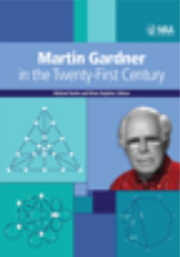Book contents
- Frontmatter
- Preface
- Contents
- I Geometry
- II Number Theory and Graph Theory
- 6 Transcendentals and Early Birds
- 7 Squaring, Cubing, and Cube Rooting
- 8 Carryless Arithmetic Mod 10
- 9 Mad Tea Party Cyclic Partitions
- 10 The Continuing Saga of Snarks
- 11 The Map-Coloring Game
- III Flexagons and Catalan Numbers
- IV Making Things Fit
- V Further Puzzles and Games
- VI Cards and Probability
- VII Other Aspects of Martin Gardner
- Index
- About the Editors
8 - Carryless Arithmetic Mod 10
from II - Number Theory and Graph Theory
- Frontmatter
- Preface
- Contents
- I Geometry
- II Number Theory and Graph Theory
- 6 Transcendentals and Early Birds
- 7 Squaring, Cubing, and Cube Rooting
- 8 Carryless Arithmetic Mod 10
- 9 Mad Tea Party Cyclic Partitions
- 10 The Continuing Saga of Snarks
- 11 The Map-Coloring Game
- III Flexagons and Catalan Numbers
- IV Making Things Fit
- V Further Puzzles and Games
- VI Cards and Probability
- VII Other Aspects of Martin Gardner
- Index
- About the Editors
Summary
Nim
Forms of Nim have been played since antiquity and a complete theory was published as early as 1902 (see [3]). Martin Gardner described the game in one of his earliest columns [7] and returned to it many times over the years ([8]–[16]).
Central to the analysis of Nim is Nim-addition. The Nim-sum is calculated by writing the terms in base 2 and adding the columns mod 2, with no carries. A Nim position is a winning position if and only if the Nim-sum of the sizes of the heaps is zero [2], [7].
Is there is a generalization of Nim in which the analysis uses the base-b representations of the sizes of the heaps, for b > 2, in which a position is a win if and only if the mod-b sums of the columns is identically zero? One such game, Rim b (an abbreviation of Restricted-Nim) exists, although it is complicated and not well known. It was introduced in an unpublished paper [6] in 1980 and is hinted at in [5]. Despite his interest in Nim, Martin Gardner never mentions Rim b, nor does it appear in Winning Ways [2], which extensively analyzes Nim variants.
In the present paper we focus on b = 10, and consider, not Rim10 itself, but the arithmetic that arises if calculations, addition and multiplication, are performed mod 10, with no carries. Along the way we encounter several new and interesting number sequences, which would have appealed to Martin Gardner, always a fan of integer sequences.
- Type
- Chapter
- Information
- Martin Gardner in the Twenty-First Century , pp. 45 - 52Publisher: Mathematical Association of AmericaPrint publication year: 2012



